Key information
Publication type: General
Publication date:
Contents
1. Foreword
Our city’s wonderful parks and green spaces have been a real lifeline during the COVID-19 pandemic, especially for those Londoners without their own gardens. Our green spaces have been a source of respite, a place to exercise, and somewhere to meet friends safely outdoors. Never have they been more important for our health and wellbeing.
But we know that not all Londoners have good access to green spaces. This is a matter of social justice, and like many of our city’s existing inequalities, this imbalance has been brought into sharp focus by the pandemic. Our green spaces and natural environment – parks, woodlands, nature reserves, rivers, canals and more – have a vital role to play in tackling the climate and ecological emergencies we face. They help to keep London cool, provide shade and reduce the risk of flooding. They also provide homes for wildlife and bring nature closer to Londoners.
That is why I pledged in my manifesto this year that no Londoner should live more than a 10-minute walk from green space and why protecting, restoring and increasing London’s green spaces is at the heart of my Green New Deal for London. Our recovery from COVID-19 must be a green one, and I am determined to take the bold action required to lead a just transition to a greener economy, healthier city and more equal society.
I am proud of the environmental achievements of my first term, from introducing the world’s first Ultra Low Emission Zone (ULEZ) and setting out my ambition for London to be zero-carbon by 2030, to becoming the world’s first National Park City and planting a record 340,000 trees. But I want to go much further and faster. Cleaning London’s air and tackling the climate and ecological emergencies will be a top priority during my second term as Mayor. As part of my £6 million package of fresh investment in green spaces announced at the end of June, I am now delighted to invite applications to my £4 million Green and Resilient Spaces Fund. This will complement my Grow Back Greener fund by supporting larger scale green space projects, helping to tackle the climate emergency by reducing the risk of floods and keeping our city cool. This could include restoring rivers, creating new wetlands, opening up new green connections between communities, or creating new woodlands. Funding will be targeted where it is most needed, using cutting-edge data, including our new climate risk mapping, that highlights where Londoners are most vulnerable to the impacts of climate change. It will also target areas with the least access to green space. We look forward to receiving your proposals.
Sadiq Khan
Mayor of London
2. Overview of the Fund
The Green and Resilient Spaces Fund is part of the London Recovery Board’s Green New Deal Mission, one of nine missions jointly developed by the Mayor and London Councils to guide the capital’s recovery from the COVID-19 pandemic. The Green New Deal Mission aims to tackle the climate and ecological emergencies and improve air quality by doubling the size of London's green economy by 2030 to accelerate job creation for all. The Green and Resilient Spaces Fund projects should help deliver the Mission’s four overarching objectives:
- improve London’s natural environment, improve air quality and tackle the climate and ecological emergency
- promote and incentivise activities that sustain and grow London’s green economy
- prioritise interventions reducing health inequalities and social injustices
- engage Londoners and businesses in the journey to become a zero pollution and greener city.
Greening London’s public realm, improving access to and enhancing green spaces, and increasing the capital’s resilience to the impacts of a changing climate are critical to achieving the aims of the Green New Deal Mission. In his manifesto, the Mayor also committed to bringing nature close to Londoners, to protect, restore and improve green spaces in the city, and set a goal for all Londoners to live within a ten-minute walk from green space.
The Green and Resilient Spaces Fund is an invitation to London boroughs and other organisations with responsibility for public spaces to contribute to a green recovery by delivering exemplar projects at scale. A total of £4 million is available, and we will offer grants of between £250,000 and £750,000 for projects that can start in 2021-22 and be completed by March 2024.
We will fund around 10 exemplar Green and Resilient Space projects, (see Box 1). Up to eight further projects may be selected for development funding in order to create a pipeline of projects ready to deliver when additional funding becomes available. Selected projects will be located in London’s most disadvantaged and climate vulnerable areas or areas where residents have been most severely affected by the pandemic.
All projects must demonstrate how they will benefit their local community. GLA research has found that women, adults under-25, lower-income Londoners and social renters visit parks less often than other Londoners. We are particularly keen to support projects that will provide opportunities and positive outcomes for these groups and for Black, Asian and minority ethnic Londoners who are more likely to live in areas of deficiency of access to green space or in areas where green-space quality is poor. We strongly encourage proposals that actively involve local stakeholders, including community groups, in project development, design and implementation.
Green and Resilient Spaces are parks, green spaces and the wider public realm which is designed and managed to provide accessible and welcoming space for people and wildlife. They will be planned as part of a wider network of green infrastructure to encourage sustainable, active travel and support biodiversity. They will use nature-based interventions to reduce the impact of climate change such as green sustainable drainage to reduce flood risk, tree planting for shade and to reduce over-heating and wildlife-friendly planting to enhance biodiversity.
Green and Resilient Spaces projects will support a green recovery from the COVID-19 pandemic and aim to tackle the climate and ecological emergencies, whilst addressing London’s health and social inequalities. They should create opportunities for all Londoners, especially those from under-represented communities to access training to develop green skills, and to access green spaces, including by volunteering.
We will fund Green and Resilient Space projects which are innovative and develop approaches that are can be shared and replicated in other areas.
The Green and Resilient Spaces Fund has a two-stage application process. We are calling for Expressions of Interest to be submitted by 30 September 2021. A shortlist of applicants will then be asked to submit a detailed application by December 2021 or will be offered a development funding. Project grants will be awarded by February 2022.
The Green and Resilient Spaces Fund is part of a wider package of measures that the Mayor has launched in 2021 to support the Mission, including:
- Grow Back Greener Fund, to support community projects to increase access to green spaces and enhance our resilience to climate change.
- Future Neighbourhoods 2030 programme, to tackle London’s environmental challenges in an integrated way in some of London’s most disadvantaged and climate-vulnerable communities.
3. Funding available
The Green and Resilient Spaces Fund is a £4 million multi-year programme. The fund will be distributed as follows:
Project funding
- Grants of between £250,000 and £750,000 to cover 70 per cent of the cost of delivery of exemplar Green and Resilient Spaces projects. A minimum of 30 per cent of the overall cost must be match funded. The projects will be expected to start in 2021/22, deliver tangible outputs and impact in the first 12 months, with the majority of the grant being spent by March 2023. Projects should be completed by March 2024.
Development funding
- Grants of up to £50,000 to cover 70 per cent of the cost of developing exemplar Green and Resilient Spaces projects, (e.g. feasibility studies, initial design work, public engagement). A minimum of 30 per cent of the overall cost of the development work must be match funded. Development work will be expected to start by November 2021 and complete by December 2022.
Development funding will be offered at Stage 1 in the application process, following submission of Expressions of Interest. The assessment panel will identify applications which are considered to require additional development work in order to deliver the quality of outcomes required or need additional work to reach a stage where they can be considered ‘shovel-ready’ for future grant applications.
If your project is identified for development funding, feedback will be provided to help you focus on areas that need development or re-scoping and additional in-kind support will be available to help you to meet our requirements and respond to our recommendations.
Development funding may be offered for feasibility studies and other research, public engagement, technical reports, visioning and design work. It is expected that development work will progress projects to delivery stage, (completion of RIBA Stage 3 Spatial Coordination or Landscape Institute Stage 3 Developed Design), and will be completed by December 2022.
As there is a single round of funding for project implementation, an offer of development funding will not necessarily lead to future project funding. However, it will enable the project to become part of a pipeline of ‘shovel-ready’ exemplar projects for when other funding becomes available.
Project support
Applicants may be offered additional in-kind support from members of a Green and Resilient Spaces Expert Panel, both for projects in development and in delivery. The Panel will comprise Mayor’s Design Advocates with relevant expertise and experience. This support is funded as part of the programme and will be allocated to projects based on need and availability of relevant experts. It is expected that selected projects may be allocated between three and eight days of Expert Panel support over the course of the project. Expert Panel involvement will help ensure the projects are exemplary by providing a ‘critical friend’ role, offering advice and sharing knowledge. Expertise on offer will include community engagement and co-design, landscape and public realm design, and management, ecology, biodiversity and sustainable development technologies such as natural flood management and the design of sustainable urban drainage systems.
Match funding
Projects must provide a minimum of 30 per cent of project costs as match funding. This may include:
- in-kind support (we will accept up to 10 per cent of project costs to be in-kind match)
- other local and national government funding streams
- private sector investment or grants
- private sector activity through partnerships
- other grants.
Applicants should note that grant funding from other GLA funds cannot be used as match for the Green and Resilient Spaces Fund.
4. Who can apply?
The Green and Resilient Spaces Fund is open to public and civil society organisations.
This includes:
- local authorities
- other relevant public bodies (eg. NHS Estates)
- housing associations
- registered charities including Charitable Incorporated Organisations
- formally constituted community groups
- social and not-for-profit businesses including Community Interest Companies and social enterprises
- Community Benefit Societies
- tenants and residents’ associations, or Tenant Management Organisations (TMO).
We welcome proposals from partnerships which build on the strengths of different organisations, including collaboration with private sector partners but a clear public or civil society sector lead organisation must be identified that is able to take overall responsibility for the delivery and management of the project.
Individuals cannot apply as a lead applicant. The lead organisation for your project must be legally constituted and able to enter into a contract.
Applicants must have landowner permission to carry out the project on the site.
If you are not sure whether your organisation or partnership is eligible to apply, please contact us on: [email protected]
5. What will we support?
Green and Resilient Spaces projects will help create neighbourhoods with good access to high quality green spaces and a green and climate resilient public realm which supports the mental and physical health and wellbeing of local people. We are looking to support exemplar, large-scale projects which provide high quality green spaces close to where people live and work. These should be planned as part of a network of green spaces and green routes to encourage walking and cycling and to connect wildlife habitats, in turn linked to a wider network of green infrastructure. Existing green spaces should be enhanced to ensure they are welcoming, climate resilient and meet the needs of local people. The wider public realm should be designed to enhance climate resilience including to reduce flood and heat risk and conserve public water supplies. Smaller scale projects may be more suited to apply for our Grow Back Greener Fund which will fund community-led projects up to a value of £75,000.
The Green and Resilient Spaces Fund’s objectives are to:
- enhance London’s green and blue spaces and make the built environment greener to help the capital adapt and respond to the climate and ecological emergency
- support innovative public space projects that primarily deliver climate resilience and greening outcomes but also contribute to air quality and active travel objectives
- address the environmental and health inequalities highlighted by the COVID-19 pandemic by prioritising interventions that target the areas of highest need due to climate vulnerability and multiple deprivation and that benefit the communities most impacted by the pandemic
- build capacity and green skills as part of the Mayor’s Green New Deal ambition to double the green economy in London.
The Green and Resilient Spaces Fund will prioritise projects and strategies that deliver outcomes in line with the Green New Deal and programme objectives including:
- improved access to green space to support physical and mental health and reduce health inequalities, especially amongst Londoners currently lacking good access to open space
- increased resilience to the impacts of climate change, including through providing shade, reducing the risk of overheating, reducing surface water and fluvial flood risk and conserving water resources
- improved air and water quality, and reduced exposure to air pollution
- enhanced biodiversity and ecological resilience, creation of wildlife habitat and increased tree canopy cover
- increased green skills, local community capacity and cohesion
- enhanced connectivity between green spaces, and spaces which encourage walking and cycling.
The types of projects that the Green and Resilient Spaces Fund might fund are demonstrated in the case studies in this prospectus, and include:
- creation of new high-quality public green spaces, especially in locations where current access is poor and where this would help reduce health inequalities
- better management of water and reduced flood risk through sustainable drainage and natural flood management measures, local water storage and reuse, restoring waterways and creating wetlands
- restoration and creation of wildlife habitats to help support London’s Nature Recovery Network, especially creating and restoring priority habitats including species-rich woodland and flower-rich grassland
- improvements to the accessibility of green spaces through new entrances, access routes and green connections between sites, or by opening up currently inaccessible sites
- improvements to the design of green spaces to make them more inclusive to all Londoners, especially those from communities who are underrepresented in green spaces
- improvements to streets and other public spaces by retrofitting green and climate resilient infrastructure including sustainable drainage, trees, cool roofs and outdoor cool spacesReference:1 and pocket parks
- activation of underperforming open spaces, such as those on many of London’s housing estates (including making them more welcoming to non-residents, adding food growing opportunities and providing new skills opportunities), or poorly used amenity green spaces.
Location of project sites
Projects must be on sites which are (or will be) freely publicly accessible. We will prioritise projects which are located in areas of high climate vulnerability based on the London Climate Risk Maps, (see Box 2).
Box 2: Priority locations
Vulnerability to the risks and negative health effects of climate change are unequally distributed throughout our city. These risks disproportionately affect those on low incomes and Black, Asian and minority ethnic Londoners. This has been highlighted by the COVID-19 crisis, where existing inequalities have further exacerbated impacts of the pandemic, particularly for those in deprived neighbourhoods.
The London Climate Risk Maps highlight climate vulnerability across London. Climate vulnerability relates to both people’s exposure to climate impacts, like flooding or heatwaves, and to personal and social factors that affect their ability to cope with and respond to extreme events.
These maps bring together key metrics on exposure to climate risk, such as flood risk, access to open space, air pollution and heat, with vulnerability metrics including concentrations of younger and older people, and deprivation. The maps use the same ‘hex’ grid as the Green Infrastructure Focus map, and show overall climate risk as well as separate maps for flood risk and heat risk.
Applicants must evidence how their proposed project will be designed to address these risks. Appendix 1 includes more details on how to use the London Climate Risk Mapping.
In addition to identifying climate risk, applicants will also need to outline the rationale for the selection of the chosen site and the proposed green infrastructure improvements using a range of appropriate data or evidence.
The GLA has published a series of maps and data to help Londoners understand, explore and improve our capital’s green infrastructure. We encourage you to use these tools to help inform the type of greening activities that your project might include, and to identify locations that are in greatest need. The following tools are particularly relevant:
- Green Infrastructure Focus Map: shows where there is greatest need for green infrastructure interventions that can tackle local environmental and social challenges. It can help identify where improvements might be best targeted, and what they could focus on. Appendix 1 includes more details on how to use the Green Infrastructure Focus Map.
- Access to Open Space Map: shows the proportion of households within each area that are located in an Area of Deficiency in access to local and district public open space (AoD).
- Green cover map: shows how much of London is covered by trees, plants and open water. It helps to identify areas of the city that have low green cover and could be targeted for projects.
- Tree canopy cover map: shows how much of London is covered by trees. It helps to identify areas of the city that have low tree cover and could be targeted for tree planting or natural regeneration.
- Deprivation data: you can find out more about different indices of deprivation through the London Datastore, or Department for Housing, Communities and Local Government’s interactive map.
Size and strategic fit
Applicants should demonstrate that the proposed site is of strategic significance in terms of location and size. Project sites could comprise a single large park or green space (of around District Park size or larger as defined in Page 320 of the London Plan), or be a series of interlinked spaces which together are of strategic significance. This could be green spaces across a housing estate or projects within a defined neighbourhood, reimagining the wider public realm including major sustainable drainage schemes in streets and squares which contribute to new greening.
Applicants should also demonstrate how their proposed projects fit within a wider green infrastructure or green space strategy and a wider strategy for climate change adaptation and mitigation. Alignment with other relevant strategies and plans should also be considered including local urban forest plans, nature recovery plans, Joint Strategic Needs Assessments and Health and Wellbeing Strategies.
Equality
As a public-sector organisation, the GLA must have due regard to the Public Sector Equality Duty and the need to eliminate unlawful discrimination, harassment, victimisation and any other conduct which is unlawful under the Equality Act 2010. It must advance equality of opportunity and foster good relations between people who share a protected characteristic and people who don’t have that characteristic. As recipients of public funding, successful applicants will also need to meet this Duty.
As part of the London Recovery programme, the London Recovery Board gave the missions a strong mandate to address inequalities, and in particular the racial inequalities that have had such a devastating effect on Black, Asian and minority ethnic people during the COVID-19 pandemic. Appendix 2 includes a checklist for addressing inequalities.
We encourage you to develop the rationale for your proposal using current and robust socio-economic data as well as qualitative analysis. Projects will be required to evidence the environmental, social and economic impact of their intervention and to evaluate the performance of their project once delivery is complete.
Monitoring the impact of projects using qualitative and equalities data (gender, age, disability, ethnic background, religious background, sexual orientation) is an integral part of this, and successful projects will report to us regularly so that we can track their progress.
Permissions and risks
Projects will need to be developed to a stage that they can be delivered on the ground by 2024 with the majority of the grant being spent by March 2023. This is expected to be completion of RIBA Stage 3 Spatial Coordination or Landscape Institute Stage 3 Developed Design. If your project requires planning permission or other permits, these should either be secured at time of application or to be secured by the time a grant agreement is signed (i.e. by February 2022). We expect any risks to project delivery, (such as potential land contamination), to be identified and mitigated.
What we won’t fund
The Fund cannot be used towards the following costs:
- land purchase
- capital items that are not primarily about improving green space e.g. improving a building or other grey infrastructure (however, match funding can be used for this type of element where this is part of a project)
- “business as usual” activities e.g. routine maintenance
- projects that have already started, or are a continuation of existing work, (unless it is clearly a distinct new phase of a former project with separate outcomes)
- core staff costs or other core costs that are not project specific.
Sharing Best Practice
We will expect grant recipients to share their knowledge and best practice to help accelerate the changes required across London to create healthy, sustainable places and to tackle the climate and ecological emergencies.
Applicants should identify how they will share best practice with other organisations across London (see Box 3).
Box 3: Sharing Best Practice
Green and Resilient Spaces grant recipients will be expected to share knowledge and best practice from their experience of developing and implementing the projects.
Successful applicants may wish to:
- Create a project webpage or portal
- Publish case studies
- Form a Best Practice Sharing Group with other successful applicants, interested local authorities, community groups or organisations
- Host site visits and tours and workshops
6. How to Apply
The Green and Resilient Spaces Fund has a two-stage application process:
- Expression of Interest
- Full Application.
Stage 1 - Expression of Interest
You may submit an Expression of Interest for project funding by 5pm on Thursday 30 September 2021. You should read this guide and the application form carefully before starting your application. We will publish online answers to frequently asked questions. Consider whether your proposal addresses the Green and Resilient Spaces Fund and the Green New Deal objectives set out in this guide before deciding to apply. If you need further guidance and advice, please get in touch at [email protected]. While we cannot help you with the specific content of your application, we can advise you on the eligibility and suitability of your proposed activities.
Only applications received by 30 September will be assessed for invitation to the full application stage. Applications submitted after this deadline will not be accepted. A panel of GLA officers and members of the Green and Resilient Spaces Expert Panel will review applications against a set of criteria. These are set out in How will your application be assessed.
If your project is successful in progressing to the full application stage, we will inform you of the necessary next steps. At this point, we may offer you additional support to develop your project.
The Stage 1 appraisal process will categorise applications as follows:
- Not suitable for funding – Rejected (feedback will be given on unsuccessful applications)
- Requires further development – Development funding offered
- Suitable to move to a Stage 2 – Full application
Development funding
If your project is considered to require further development, you may be offered development funding at Stage 1. Applications identified for development funding will be those which are considered to have potential to meet the programme requirements but require additional work before they could receive project funding. Feedback will be provided to help you focus on areas that need development or re-scoping and the scope of development work to be funded will be agreed by negotiation.
Development funding may be offered for feasibility studies and other research, public engagement, technical reports, visioning and design work. It is expected that development work will progress projects to detailed design and planning application stage (i.e. completion of RIBA Stage 3 Spatial Coordination or Landscape Institute Stage 3 Developed Design), and must be completed by December 2022.
As there is a single round of funding for project implementation, an offer of development funding will not necessarily lead to future project funding. However, it will enable the project to become part of a pipeline of ‘shovel-ready’ exemplar projects for when other funding becomes available.
Additional support may be available to help you to meet our requirements and respond to our recommendations. The support offered will depend on our assessment of your project’s needs, but may include:
- A targeted workshop or working group session on your proposal
- Ongoing support from GLA officers or members of the Green and Resilient Spaces Expert Panel.
Stage 2 - Full Application Stage
The Stage 2 application process will be managed through the Greater London Authority’s online investment management system, GLA OPS. Instructions will be given to applicants invited to make a Stage 2 full application about how to register and submit an application in GLA OPS.
If your project is considered suitable for a Stage 2 Full Application, you will be notified via email. Some proposals may be ready to submit a full application with very little additional support from GLA. However, we anticipate that in some cases there will be a period of feedback and negotiation to agree specific details to ensure your full application has the best possible chance of approval.
Please note, the process remains competitive at the full application stage. Being invited to submit a full application does not guarantee that your project will receive funding.
The Stage 2 appraisal process will categorise applications as follows:
- Not suitable for funding – Rejected (feedback will be given on unsuccessful applications)
- Suitable for funding – Grant Offer made subject to Contract
Stage 3 – Getting into Contract
Projects which are selected for development funding at Stage 1 or project funding at Stage 2 will be issued a template of the contract or agreement for their project. Please ensure that you have all necessary resources and approvals in place to enable the agreement to be signed promptly if you are awarded funding. Failure to do so may result in the offer of GLA funding being withdrawn.
Key Application and Delivery Dates
7. How will your application be assessed?
Applications will be assessed by a panel of GLA officers and members of the Green and Resilient Spaces Expert Panel who will score and rank them against the criteria below:
Meeting the aims of the Fund (weighting: 40 per cent)
Applicants should set out a clear vision for what the project aims to achieve based on an understanding of local challenges and needs. They should show how project elements will contribute to the objectives of the Green and Resilient Spaces Fund and how they fit with wider strategies for green infrastructure, health and climate resilience. Applications will also be judged on whether the proposed project is of an appropriate scale and in a priority location, (as set out in Box 2).
Engaging and supporting Londoners (weighting: 20 per cent)
Applicants should set out how projects will meet the needs of Londoners, especially people who are less likely to access green space. They should also show how projects will provide opportunities for Londoners to play an active part in project development and design and to develop new skills, including through training and volunteering.
Readiness to deliver (weighting: 20 per cent)
Projects must be developed to a stage that they can be completed by March 2024 at the latest, with match funding secured. Applicants must set out the stage the project has reached at time of application, (i.e. RIBA or Landscape Institute work stage) and any permissions secured or required. Any permissions required such as landowner agreements, environmental permits and planning permission must be secured by the time the grant funding agreement is awarded (by February 2022).
Applicants will need to demonstrate value for money, showing that the proposed approach makes optimal use of resources, including match funding, to achieve a high-quality project. Whilst a detailed cost breakdown is not expected to be provided at Stage 1, applications should demonstrate that all costs associated with the project have been identified and considered.
Applications will also need to clearly outline risks and mitigation strategies associated with the proposed project.
Leaving a positive legacy (weighting: 20 per cent)
Applications should include a clear set of outcomes and have a plan and resources for future maintenance. All projects will need to be maintained to a high standard in the future. Applicants must describe how improvements will be maintained, including details of how this will be funded and implemented. Full submissions at Stage 2 should be accompanied by a ten-year maintenance plan or show how this will be prepared.
Applications must describe the project’s proposed social, environmental and economic outcomes in line with the Fund objectives. Specific project outputs for monitoring purposes will be agreed when grants are awarded. Applicants should propose a range of outputs relevant to the project which could include:
- area of new publicly accessible green space (m2 or hectares)
- area of green space with improved quality (m2 or hectares)
- number of trees planted
- area of priority habitat restored or enhanced (m2 or hectares)
- reduction of households within area of deficiency of access to green space
- reduction in impervious/ sealed surfaces (m2)
- area draining to sustainable drainage systems (m2)
- number of cool spaces created or enhanced
- increase in visitor satisfaction
- length of new and improved walking and cycling routes connecting green spaces
- number of new jobs created
- number of volunteers involved
- increase in visitor numbers
- number of stakeholder groups involved.
Case studies
This new 1.3km (0.8 mile) walking and cycling route opened-up a previously unloved and underused green space. Co-designed with residents, the linear route now links communities to the Thames at Barking Riverside. It offers natural play features, places to sit and an improved waterside landscape with over 100 new trees. Robert MacFarlane and Jackie Morris have created a ‘Lost Words’ trail with artist Katy Hallett showcasing the park’s new plant life.
Photo: Sustrans
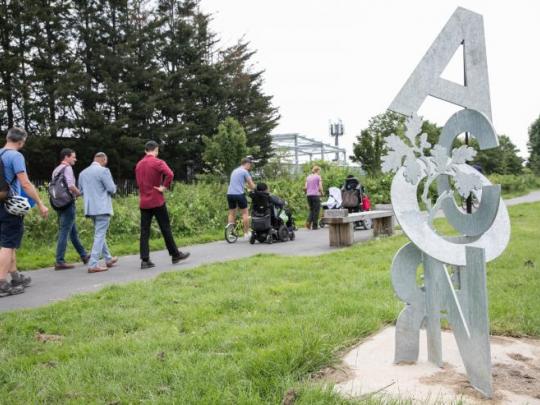
This new walking and cycling route by the river Brent, connects Greenford town centre and Gurnell Leisure Centre. Volunteers, the ‘Gurnell-Greenford Greenwayers’ helped clean up the river, while new wetlands and flower-rich meadows were created and trees planted across the park to reduce flooding and improve water quality. The result is a rich, biodiverse landscape of meadows, woodland and orchards.
Photo: Friends of Perivale Park
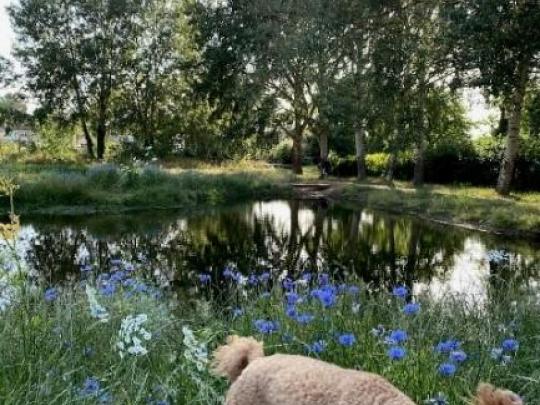
Improvements to these 16 hectares of parkland completed in 2020, have made the place feel safer, more welcoming and accessible with new walking and cycling paths. Rewilding the stream banks and new wetlands have already attracted wildlife and reduced flooding downstream and visitors can now enjoy new play spaces, a skate park and a community cafe.
Photo: Jon Sheaff Associates
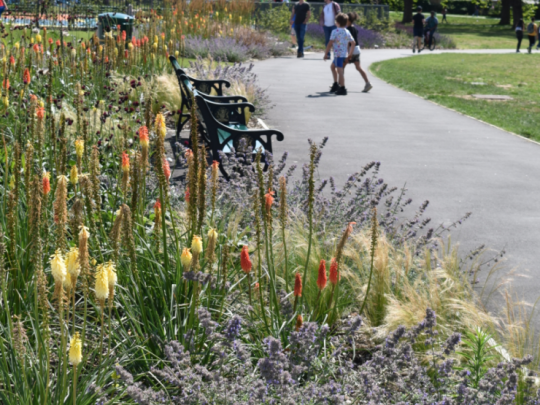
This new 285-metre long swimming lake opened in July 2019’s National Park City Festival week. Created as part of the park’s £6m heritage restoration, it’s been a big hit with ‘wild’ swimmers and wildlife alike. Places where people can cool off will help Londoners stay healthy and happy as our summers get hotter.
Photo: James O Jenkins
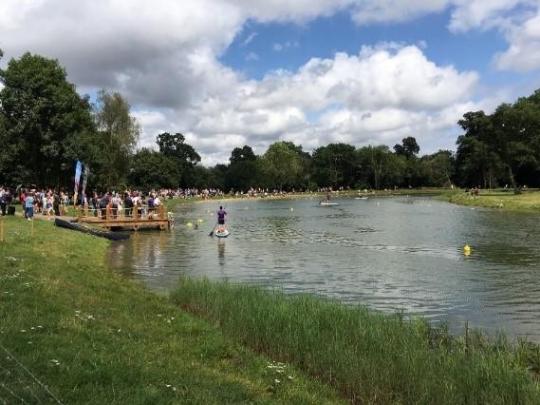
This project transformed Australia Road in the White City Estate into a community space whilst also improving water quality and reducing surface water flood risk. Located between a school and two playgrounds, the project directed rainwater underground into a series of bio-retention basins and rain gardens. These also take rainwater from the school roof via disconnected downpipes, providing over 55m3 of storage capacity. Fifty trees and 2,500 plants have also been planted to soak up rainwater and increase biodiversity.
Photo: Robert Bray Associates
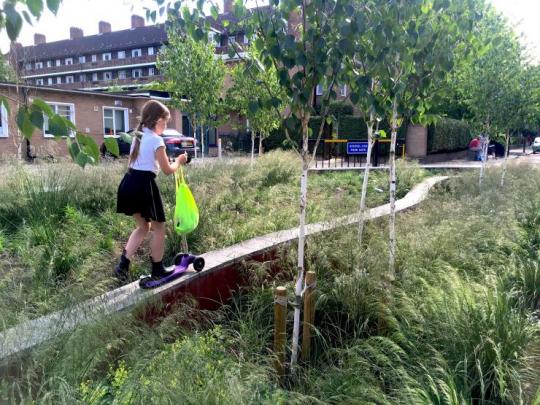
The Making Space for Nature campaign is engaging local citizens in co-creation of spaces as part of an EU funded ‘CLEVER Cities’ programme. Through this work, under-used public spaces across South Thamesmead are being transformed with Nature Based Solutions such as: rain gardens; tree planting; natural play; and edible planting. These solutions are designed to help address common urban challenges such as childhood obesity and adult loneliness, while helping to mitigate the impacts of climate change.
Photo: Richard Heald
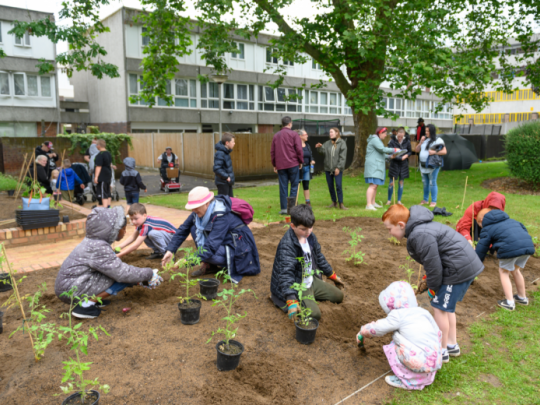
Appendix 1: using maps and data
1. Using the Green Infrastructure Focus Map
The Green and Resilient Spaces Fund will prioritise projects that are in areas of the city that have poorer access to green space. You can use our Green Infrastructure Focus Map to find out what proportion of households around your project location are deficient in access to open space.
There are two ways to access this information, using our simple Access to Open Space Score map, or using the full Green Infrastructure Focus Map. Whilst the Access to Open Space map will simply provide the relevant score for your location, the Green Infrastructure Focus Map allows you to view a wide range of other environmental and social information.
1.1. Using the Access to Open Space Score map
i. Go to the map at https://maps.london.gov.uk/aod/. The map now shows the Access to Public Open Space score for each “hex” area. The white areas show where access to public open space is worst, and the dark grey areas show where access is best. Some areas are coloured black, showing no data, because there are no households located here (this includes some large green spaces).
ii. Type your project postcode or address in the search bar at the top of the page and press enter.
iii. The map will zoom in and navigate to your chosen address, displaying a red dot at the location. Hovering your mouse over the dot will display the Access to Open Space score for your location (see image below). The score will be between 0 and 1, and represents the proportion of households within the hex that are located in an area of deficiency of access to local and district public open space (AoD). A score of 1 means that all households are in an AoD, whereas a score of 0.5 means that half of the households are in an AoD. Some locations that are in larger green spaces may display no data if the hex contains no households. In this case you may wish to navigate to a neighbouring hex.
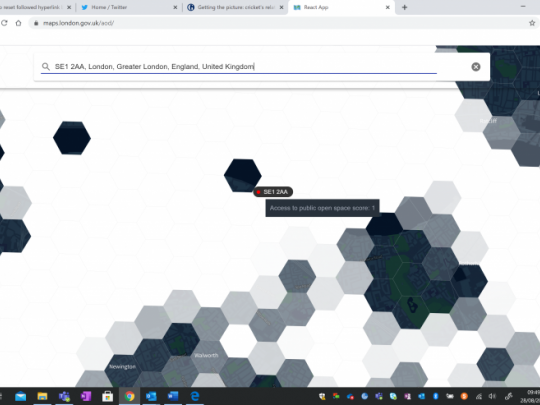
1.2. Using the Green Infrastructure Focus map
- Go to the Green Infrastructure Focus Map at https://maps.london.gov.uk/green-infrastructure/. The map works best on a computer rather than a mobile phone.
- On the menu on the left-hand side of the screen, click on the “Map Variable” drop-down menu, and click on “Access to Public Open Space”. The map now shows the Access to Public Open Space score for each area. The white areas show where access to public open space is worst, and the dark grey areas show where access is best. Some areas are coloured black, showing no data, because there are no households located here (this includes some large green spaces).
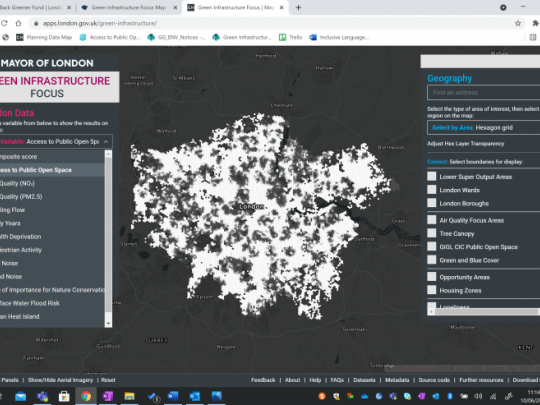
iii. In the search box in the top right-hand corner of the map, type the address or postcode for your project location and press enter. The map will navigate to the relevant location. Hovering over the hex that contains your location will display the Access to Public Open Space score for your site in the menu on the left-hand side. The score will be between 0 and 1 and represents the proportion of households within the hex that are located in an area of deficiency of access to local and district public open space (AoD). A score of 1 means that all households are in an AoD, whereas a score of 0.5 means that half of the households are in an AoD. Some locations that are in larger green spaces may display no data if the hex contains no households. In this case you may wish to navigate to a neighbouring hex. You can also adjust the hex layer transparency to make it easier to see the underlying map.
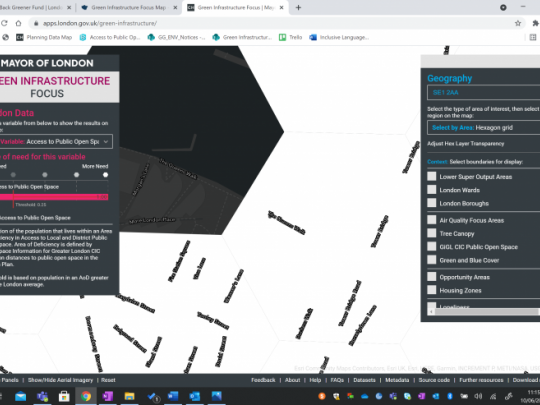
iv. By clicking on the hex, you can bring up the full range of variables for this location. This data can provide further information to help provide evidence of the need for your project, or to inform your choice of project. For example, the data may highlight poor air quality, health deprivation, or surface water flood risk.
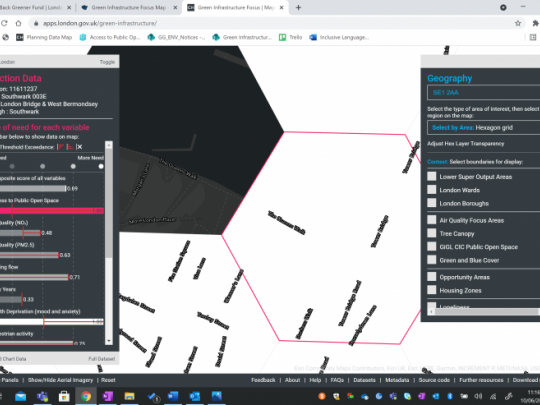
2. Using the London Climate Risk Mapping
The Green and Resilient Spaces Fund seeks to prioritise projects that can benefit people in areas of London with high levels of climate exposure and vulnerability. You can use our Climate Risk Maps to find out about how your area is affected by these factors. You will be asked to refer this information as part of your application.
Climate vulnerability relates to people’s exposure to climate impacts like flooding and heatwaves, but also to the personal and social factors that affect their ability to cope with and respond to extreme events. High climate risk coincides with areas of income and health inequalities. A series of citywide maps overlays key metrics to identify areas within London that are most exposed to climate impacts (heat and surface water flood risk) with high concentrations of vulnerable populations.
2.1. Using the Climate Risk Maps
Go to the Climate Risk Maps on the London datastore.
There, you will find a link to the interactive maps and a methodology document explaining the metrics and methodology.
i. Click on the interactive map. The map will show the climate risk score for each “hex” area.
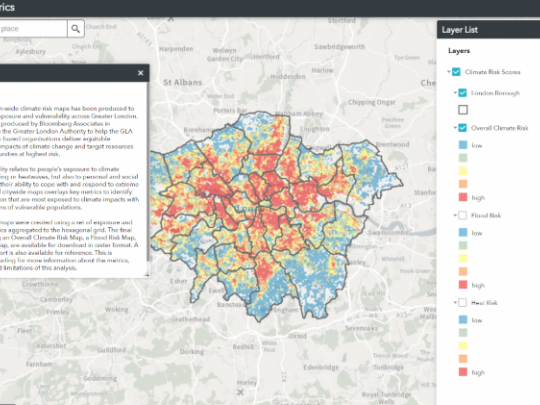
ii. Type the postcode of your project into the search bar at the upper left of the screen and click on the search button, or hit enter
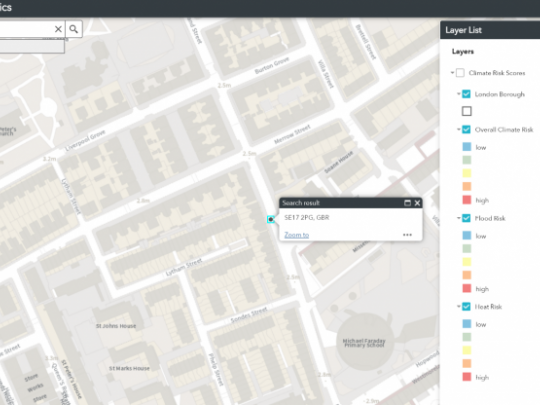
iii. Use the Layer List at the right side of the screen to show Overall Climate Risk, Flood Risk, and Heat Risk at the postcode or borough you’ve selected. The map below shows Overall Climate Risk:
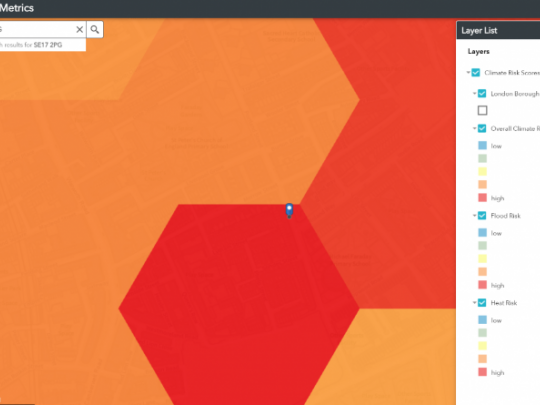
This map shows Flood Risk for the same location:
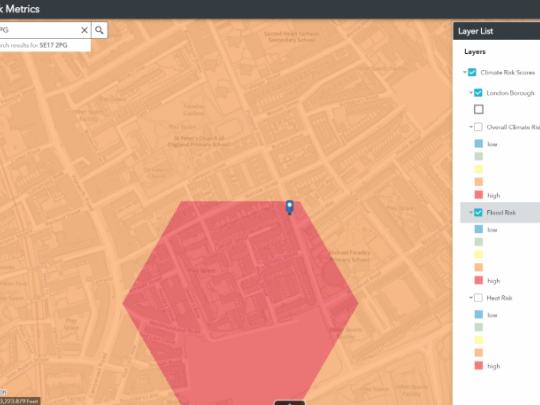
And this map shows Heat Risk for the same location:

Use the map to identify the climate risk in your area as evidence in support of your project, and to consider how your proposed project activities will address the risks highlighted.
Appendix 2: checklist for tackling inequalities
Green and Resilient Spaces projects should be designed to address inequalities. Most long-term structural inequalities are well known and have been further exposed and deepened by the pandemic. Actions to consider include:
- Consider intersectional barriers – for example, disabled women can be disadvantaged by both gender and disability status.
- Be as specific as you are able to be about the groups where impact is needed for example, don’t use ‘BAME’ if you mean young Black men.
- Gather evidence (data and community intelligence) to understand and help prioritisation of project elements.
- Assess the potential for projects to create inequalities, identifying mitigations.
- Consider how long-standing structural inequalities may impact a project’s success.
- Identify what can be measured and how this might indicate success.
- Record how evidence and intelligence are used to shape programmes.
Additional checklist for projects:
Must not
- Create further, or deepen existing, inequalities.
- Assume a lack of data means problems do not exist.
- Perpetuate discrimination for groups experiencing inequality through the language used or the approach taken.
Nice to have
- Co-design projects with experts by experience (people with lived experience).
- Contributing new evidence to fill gaps.
- Case studies to demonstrate leadership by example.
Prompts for different project phases
Project initiation prompts:
- Evidence - what evidence do you need to provide best insight into key [equalities] groups?
- Expertise and engagement - which expert stakeholder organisations or communities will contribute insight on this issue?
- Inclusive approach – what process will you use to design a programme which is inclusive and proactively addresses barriers experienced by specific groups? Can experts-by-experience co-design or co-lead with us?
- Evaluation - How will you track change for target groups?
Design stage prompts:
- Evidence – what data and evidence did you use to understand inequalities?
- Expertise and engagement – how does evidence and insight from stakeholders help to shape your programme?
- Inclusive implementation – how are the needs of priority groups being considered in the design of the programme/project?
- Assess – assess whether there is potential for the policies or programmes to create further inequalities?
- Evaluation – what will be measured and how will this indicate success?
Evaluation stage prompts:
- Evidence – what evidence on need and impact on equalities groups did you use to help shape this project?
- Expertise and engagement – what insight did equalities experts and experts with lived experience give you about the impact on target groups? How was this community intelligence used to shape the programme?
- Inclusive implementation – how are the needs of priority groups addressed in the proposal?
- Assess – ensure the process used to assess and record impacts are recorded in a project plan.
- Evaluation – what metrics will be monitored, when, by whom and how will they feed into reporting?
Other formats and languages
For a large print, Braille, disc, sign language video or audio-tape version of this document, please contact us at the address below:
Greater London Authority
City Hall
The Queen’s Walk
More London
London SE1 2AA
Telephone 020 7983 4000
www.london.gov.uk
You will need to supply your name, your postal address and state the format and title of the publication you require.
If you would like a summary of this document in your language, please phone the number or contact us at the address above.
References
- Reference:1Cool spaces are areas where Londoners can take respite on hot days. More about Cool Spaces can be found on the Greater London Authority website: /programmes-and-strategies/environment-and-climate-change/climate-change/climate-adaptation/cool-spaces